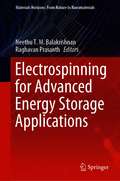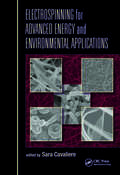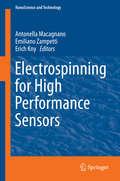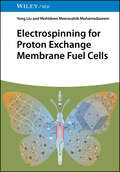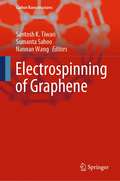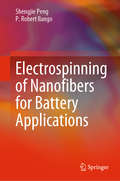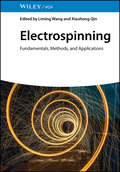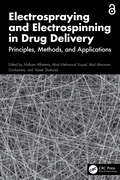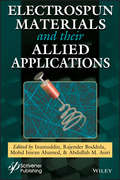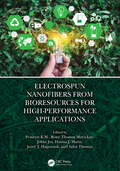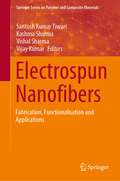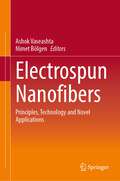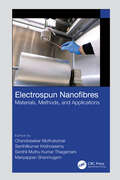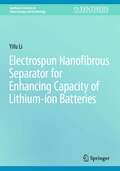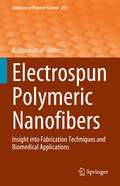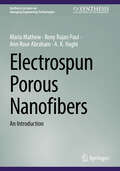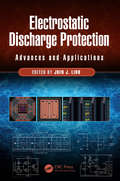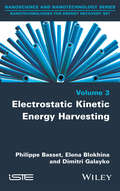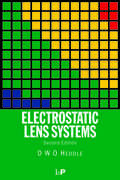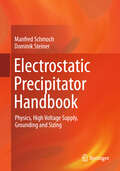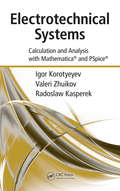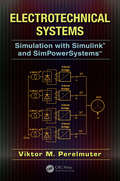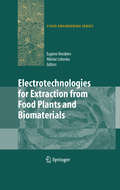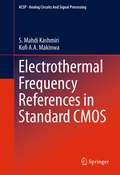- Table View
- List View
Electrospinning for Advanced Energy Storage Applications (Materials Horizons: From Nature to Nanomaterials)
by Raghavan Prasanth Neethu T. M. BalakrishnanThis book provides a consolidated description of the process of electro-spinning and detailed properties and applications of electro-spun electrodes and electrolytes in energy storage devices. It discusses the preparation, structure and electrochemical properties of nanofiber electrode and electrolyte materials. It focuses exclusively on Lithium Ion batteries, with the contents discussing different aspects of electrospinning in storage systems. This book aims to provide a comprehensive resource to help researchers choose the best electrodes and electrolyte materials based on the properties required for their desired commercial applications. It will be a useful guide to graduate students and researchers working in solid-state chemistry, physics, materials chemistry, and chemical engineering on aspects of energy storage.
Electrospinning for Advanced Energy and Environmental Applications
by Sara CavaliereElectrospinning for Advanced Energy and Environmental Applications delivers a state-of-the-art overview of the use of electrospun fibers in energy conversion and storage, as well as in environmental sensing and remediation. It first introduces electrospinning and its origins, outlining achievable one-dimensional nanoscaled materials and their applications. It then discusses the use of electrospun materials in energy devices, including low- and high-temperature fuel cells, hydrogen storage, dye-sensitized solar cells, lithium-ion batteries, and supercapacitors. It also explores environmental applications, such as the use of electrospinning-issued materials in membranes for water and air purification, and in sensors and biosensors for pollution control.
Electrospinning for High Performance Sensors
by Antonella Macagnano Emiliano Zampetti Erich KnyThis book aims to present the different aspects of electrospinning for designing and fabricating high performing materials for sensors applied in gaseous and liquid environments. Since electrospinning is a versatile and inexpensive manufacturing technology, the book emphasizes the industrial applications perspective. The volume is an edited collection of the most recent and encouraging results concerning advanced nanostructured (bio) sensors. The feats achieved by these sensors range from high sensitivity to extreme operating conditions and satisfy a wide range of requirements. Most of the contributions in this book come from First International Workshop on "Electrospinning for High Performance Sensing "(EHPS2014) that was held in Rome in 2014, as part of the European COST Action MP1206 "Electrospun Nanofibres for bio inspired composite materials and innovative industrial applications. "
Electrospinning for Proton Exchange Membrane Fuel Cells
by Yong Liu Meerasahib MohamedazeemComprehensive reference on the design, characteristics, performance, and development potential of key components of PEMFC through electrospinning technologies Electrospinning for Proton Exchange Membrane Fuel Cells discusses the use of electrospun materials in preparing next-generation fuel cell proton-conducting membranes, comprehensively reviewing the essential parts of proton exchange membrane fuel cell (PEMFC) components including the catalyst layer, gas diffusion layer, and proton exchange membrane. The book covers both electrochemical methods and hands-on experimental processes and provides a perspective of hydrogen fuel and PEMFC vehicles in the transformation of low-carbon energy. Electrospinning for Proton Exchange Membrane Fuel Cells includes information on: Working principles, current state of research, and existing obstacles of PEMFC components, as well as the role of electrospinning and nanofibers in PEMFC Physical properties and electrochemical polarization of the nanofiber catalyst layer prepared by electrospinning Water management ability of fuel cells under high inlet humidity Cold starting ability and performance aging of PEMFC through the electrospun microporous layer under high current density Experimental devices for the study of the electrospun proton exchange membrane and composite proton exchange membrane Electrospinning for Proton Exchange Membrane Fuel Cells is an excellent reference on the subject for materials scientists, catalytic chemists, polymer chemists, electrochemists, and electronics engineers.
Electrospinning of Graphene (Carbon Nanostructures)
by Sumanta Sahoo Santosh K. Tiwari Nannan WangThis book presents electrospinning as a processing technique in the field of graphene research. It brings together the current state of the art of processing, properties, and applications in different fields of science and technology of graphene and derived materials. The book not only discusses the various aspects of electrospun graphene but also covers the limitation and drawbacks of graphene owing to some of its intrinsic properties.
Electrospinning of Nanofibers for Battery Applications
by Shengjie Peng P. Robert IlangoThis book comprehensively discusses the basic principles and working mechanism of all kind of batteries towards clean energy storage devices. In addition, it focuses on the synthesis of various electrode materials with 1D architecture via electrospinning technique. This book will give a clear idea about recent synthetic strategy towards nanofibers and nanocomposites for alkali-ion storage applications. The reader could understand the formation mechanism of nanofibers and their potential application in the future energy storage system.
Electrospinning: Fundamentals, Methods, and Applications
by Liming Wang Xiaohong QinElectrospinning Unique resource highlighting new methods and emerging applications of electrospinning, such as manufacturing of nanofiber yarn, solar steam generation, thermoelectric generators, water-induced electric generators, actuators, and biomedical applications. Electrospinning introduces the basic principles and state-of-the-art methods of electrospinning in depth and continues on to highlight the most relevant and recent applications associated with the remarkable features of nanofibers. Written by two highly qualified authors with significant experience in the field, Electrospinning includes information on: History and development of the electrospinning theories and the state-of-the-art methods for fiber structure regulation, mass production of electrospun fibers, and manufacturing of electrospun fiber yarnsElectrospinning nanofiber-based evaporators for interfacial solar-driven steam generation and preparation and application of electrospun nanofibers in heat insulationResearch progress on sound absorption of electrospun fibrous materials and electrospun nanofiber-based triboelectric nanogeneratorPreparation and application of thermoelectric materials and devices based on electrospun fibers and electrospun nanofiber-based water-induced electric-generation Providing a comprehensive overview of electrospinning, including the principle, methods, and latest applications, Electrospinning is an essential resource for materials scientists, polymer chemists, chemists in industry, electrochemists, catalytic chemists, and electronics engineers.
Electrospraying and Electrospinning in Drug Delivery: Principles, Methods, and Applications
by Yasser Shahzad Abid Mehmood Yousaf Mulham Alfatama Abd Almonem DoolaaneaElectrospraying and electrospinning have emerged as powerful techniques for the fabrication of drug-loaded nano- and microstructures, offering precise control over particle size, morphology, and drug release kinetics. Electrospraying and Electrospinning in Drug Delivery provides a comprehensive overview of the principles and latest advancements, methodologies, and applications of electrospraying and electrospinning techniques in the field of drug delivery. It encompasses a wide array of topics, including but not limited to targeted drug delivery systems, controlled release formulations, stimuli-responsive materials, and biomedical applications.• Describes the most recent and successful applications of electrospraying/electrospinning in drug delivery• Covers fundamental principles, instrumentation, process parameters, and optimization strategies• Delves into the diverse range of materials employed in electrospraying and electrospinning, such as polymers, ceramics, and metals, highlighting their unique advantages and applications in drug delivery• Explores the incorporation of functional additives, such as nanoparticles and biomolecules, to tailor the properties and performance of electrospun/electrosprayed drug delivery platformsBy compiling contributions from leading experts in the field, this edited volume fosters interdisciplinary collaboration and inspires further research endeavors. The book will serve as a valuable resource for researchers, academicians, and professionals interested in understanding and utilizing these innovative techniques for enhanced drug delivery systems.
Electrospun Materials and Their Allied Applications
by Abdullah M. Asiri Mohd Imran Ahamed Rajender Boddula InamuddinThe aim of this book is to explore the history, fundamentals, manufacturing processes, optimization parameters, and applications of electrospun materials. The book includes various types of electrospun materials such as antimicrobial, smart, bioinspired systems. It focuses on the many application areas for electrospun materials such as energy storage and harvesting, catalysis, biomedical including gene delivery and tissue engineering, separation, adsorption and water treatment technologies, packaging. The book emphasizes the enhanced sustainable properties of electrospun materials, with the challenges and future developments being discussed in detail. The chapters are written by top-class researchers and experts from throughout the world.
Electrospun Nanofibers from Bioresources for High-Performance Applications
by Sabu Thomas Hanna J. Maria K. M. Praveen Rony Thomas Murickan Jobin Joy Jozef T. HaponiukNanofibers are possible solutions for a wide spectrum of research and commercial applications and utilizing inexpensive bio-renewable and agro waste materials to produce nanofibers can lower manufacturing cost via electrospinning. This book explains synthesis of green, biodegradable, and environmentally friendly nanofibers from bioresources, their mechanical and morphological characteristics along with their applications across varied areas. It gives an elaborate idea on conductive polymers for tissue engineering application as well. Features: Provides insight about electrospun nanofibers from green, biodegradable and environmentally friendly bio resources. Reviews surface characterization of electrospun fibers. Covers diversified applications such as cancer treatment, COVID-19 solutions, food packaging applications, textile materials, and flexible electronic devices. Describes the combined use of 3D printing and electrospinning for tissue engineering scaffolds. Includes Melt electrospinning technique and its advantages over Solution electrospinning This book aims at Researchers and Graduate Students in Material Science and Engineering, Environmental Engineering, Chemical Engineering, Electrical Engineering, Mechanical Engineering, and Biomedical Engineering.
Electrospun Nanofibers: Fabrication, Functionalisation and Applications (Springer Series on Polymer and Composite Materials)
by Vijay Kumar Vishal Sharma Santosh Kumar Tiwari Kashma SharmaThe book provides an up-to-date account of the various techniques of fabrication & functionalization of electrospun nanofibers as well as recent advancements. An overview of the advanced applications of such techniques in different areas is also presented. Both experimental and theoretical approaches related to electrospun nanofibers are covered along with a discussion on the inherent properties of electrospun nanofibers. Therefore, this book provides a unique resource not only to established researchers but also newcomers starting out in this field.
Electrospun Nanofibers: Principles, Technology and Novel Applications
by Ashok Vaseashta Nimet BölgenThis book presents the development of electrospun materials, fundamental principles of electrospinning process, controlling parameters, electrospinning strategies, and electrospun nanofibrous structures with specific properties for applications in tissue engineering and regenerative medicine, textile, water treatment, sensor, and energy fields. This book can broadly be divided into three parts: the first comprises basic principles of electrospinning process, general requirements of electrospun materials and advancement in electrospinning technology, the second part describes the applications of electrospun materials in different fields and future prospects, while the third part describes applications that can be used in advanced manufacturing based on conjoining electrospinning and 3D printing. Electrospinning is the most successful process for producing functional nanofibers and nanofibrous membranes with superior chemical and physical properties. The unique properties of electrospun materials including high surface to volume ratio, flexibility, high mechanical strength, high porosity, and adjustable nanofiber and pore size distribution make them potential candidates in a wide range of applications in biomedical and engineering areas. Electrospinning is becoming more efficient and more specialized in order to produce particular fiber types with tunable diameter and morphology, tunable characteristics, having specific patterns and 3D structures.With a strong focus on fundamental materials science and engineering, this book provides systematic and comprehensive coverage of the recent developments and novel perspectives of electrospun materials. This comprehensive book includes chapters that discuss the latest and emerging applications of nanofiber technology in various fields, specifically in areas such as wearable textile, biomedical applications, energy generation and storage, water treatment and environmental remediation, and sensors such as biomarkers in healthcare and biomedical engineering. Despite all these advancements, there are still challenges to be addressed and overcome for nanofiber technology to move towards maturation.
Electrospun Nanofibres: Materials, Methods, and Applications
by Senthilkumar Krishnasamy Chandrasekar Muthukumar Senthil Muthu Kumar Thiagamani Mariyappan ShanmugamElectrospinning is a versatile method to synthesize fiber materials. Electrospun Nanofibres: Materials, Methods, and Applications explores the technical aspects of electrospinning methods used to derive a wide range of functional fiber materials and their applications in various technical sectors. As electrospinning is a process that can be modified strategically to achieve different fibers of interest, this book covers the wide spectrum of electrospinning methodologies, such as coaxial, triaxial, emulsion, suspension, electrolyte and gas-assisted spinning processes. It: • Discusses a broad range of materials, including synthetic polymers, biodegradable polymers, metals and their oxides, hybrid materials, nonpolymers, and more. • Reviews different electrospinning methods and combined technologies. • Describes process-related parameters and their influence on material properties and performance. • Examines modeling of the electrospinning process. • Highlights applications across different industries. This book is aimed at researchers, professionals, and advanced students in materials science and engineering.
Electrospun Nanofibrous Separator for Enhancing Capacity of Lithium-ion Batteries (Synthesis Lectures on Green Energy and Technology)
by Yifu LiThis book offers an in-depth exploration of battery separators, a critical component in Lithium-ion batteries (LIBs). Serving as insulators between electrodes to prevent internal short circuits, these separators play a crucial role in retaining liquid electrolyte and facilitating the migration of lithium ions during battery cycling. In the face of increasing demand for high-performance LIBs across diverse applications, the development of superior separators is imperative. Among the various advancements in battery separator research, electrospun nanofibrous separators have gained significant attention. These separators exhibit compelling characteristics, including large pore size (typically above 500 nm), high porosity (typically above 70%), and an interconnected porous structure, all of which enhance ion transportation efficiency and battery cycling performance. However, a notable focus in previous studies has been on electrochemical inert materials as battery separators, which do not contribute to the battery's capacity. This book presents a comprehensive study that introduces a novel concept: the development of a redox-active separator based on electrospun polypyrrole (PPy) composite nanofibers to significantly enhance battery capacity. The book begins by exploring the effects of separators on battery performance, providing valuable insights and guidance for separator design. Then, a detailed investigation into the kinetics of in-situ polymerization of PPy with electrospun fibrous membranes as templates follows, shedding light on the mechanisms behind fabricating the proposed separator. Finally, this book presents the fabrication and characterization of the proposed separator, showcasing potential of the separator for enhancing battery capacity. This book is intended for researchers, engineers, and professionals in the field of battery technology, materials science, and electrochemistry. It is also a valuable resource for graduate students and academics seeking advanced insights into the development of high-performance lithium-ion batteries and innovative separator technologies.
Electrospun Polymeric Nanofibers: Insight into Fabrication Techniques and Biomedical Applications (Advances in Polymer Science #291)
by R. JayakumarThis volume deals with the various fabrication techniques, surface functionalization and biomedical applications of polymeric fibers possessing different scale and structure. It provides an overview of fabrication techniques such as Co-axial, Centrifugal, Melt and Yarning to procure multiscale, tubular and layered fibrous scaffold employed for biomedical applications. The chapters in this volume discusse the surface/chemical functionalization of fibers which enhance the biological properties of the fibrous scaffolds as well as the development of hybrid, layered and external stimuli-responsive fibrous scaffolds that hold potential application in biosensor and other biomedical fields. In addition, recent advances and applications of polymeric multiscale fibers in tissue engineering, regenerative medicine and drug delivery are presented. The potential use of fibrous scaffolds in bone, neural, tendon/ligament and cardiac tissue engineering, nanofibers as an antimicrobial wound dressing, employed in cancer theragnostics and in the treatment of skin/periodontal infections are discussed. The volume provides expert knowledge on the fabrication techniques, development of different scale and hybrid structure fibers, surface functionalization, layered and external stimuli responsive fibrous scaffolds. It will be beneficial to material/biomaterials scientists, bioengineering and biotechnologists by providing a better understanding on the subject of the innovative applications of fibrous scaffolds in drug delivery, tissue engineering, wound dressings and regenerative medicine.
Electrospun Porous Nanofibers: An Introduction (Synthesis Lectures on Emerging Engineering Technologies)
by A. K. Haghi Ann Rose Abraham Maria Mathew Rony Rajan PaulThis book introduces readers to electrospinning, a nanofabrication technique used to produce nanofibers, and discusses the properties and applications of these nanofibers. The book begins with an overview of the electrospinning process, and strategies for producing nanofibers with different morphologies. The advantages and limitations of the nanofiber technology, and future outlook are addressed next. Then recent and novel applications of electrospun nanofibers in different areas including biomedical, environmental, textile and energy are discussed, followed by a more detailed review of the fabrication and properties of electrospun nanofiber membranes and composites.
Electrostatic Discharge Protection: Advances and Applications (Devices, Circuits, and Systems #46)
by Juin J. LiouElectrostatic discharge (ESD) is one of the most prevalent threats to electronic components. In an ESD event, a finite amount of charge is transferred from one object (i.e., human body) to another (i.e., microchip). This process can result in a very high current passing through the microchip within a very short period of time. Thus, more than 35 percent of single-event chip damages can be attributed to ESD events, and designing ESD structures to protect integrated circuits against the ESD stresses is a high priority in the semiconductor industry. <P><P>Electrostatic Discharge Protection: Advances and Applications delivers timely coverage of component- and system-level ESD protection for semiconductor devices and integrated circuits. Bringing together contributions from internationally respected researchers and engineers with expertise in ESD design, optimization, modeling, simulation, and characterization, this book bridges the gap between theory and practice to offer valuable insight into the state of the art of ESD protection. Amply illustrated with tables, figures, and case studies, the text: <P><P>Instills a deeper understanding of ESD events and ESD protection design principles Examines vital processes including Si CMOS, Si BCD, Si SOI, and GaN technologies Addresses important aspects pertinent to the modeling and simulation of ESD protection solutions Electrostatic Discharge Protection: Advances and Applications provides a single source for cutting-edge information vital to the research and development of effective, robust ESD protection solutions for semiconductor devices and integrated circuits.
Electrostatic Kinetic Energy Harvesting
by Philippe Basset Dimitri Galayko Elena BlokhinaHarvesting kinetic energy is a good opportunity to power wireless sensor in a vibratory environment. Besides classical methods based on electromagnetic and piezoelectric mechanisms, electrostatic transduction has a great perspective in particular when dealing with small devices based on MEMS technology. This book describes in detail the principle of such capacitive Kinetic Energy Harvesters based on a spring-mass system. Specific points related to the design and operation of kinetic energy harvesters (KEHs) with a capacitive interface are presented in detail: advanced studies on their nonlinear features, typical conditioning circuits and practical MEMS fabrication.
Electrostatic Lens Systems, 2nd edition
by D.W.O. HeddleThis second edition enables readers to design lens systems for focusing beams of charged particles that have useful characteristics. The book covers the basic theory of the motion of charged particles in electrostatic fields and describes several methods for the calculation of the potential and field distribution for various electrode geometries. It emphasizes the Bessel function expansion method and the nine-point implementation of the finite difference method. The accompanying disk provides a suite of computer programs (LENSYS for MS-DOS) intended for practical use in the design and analysis of systems using round lenses with apertures or cylindrical elements.
Electrostatic Precipitator Handbook: Physics, High Voltage Supply, Grounding and Sizing
by Manfred Schmoch Dominik SteinerThe reader receives information on electrical gas cleaning systems as they are operated in power plants, steel works, cement works, chemical plants, CHP plants and biomass power plants.Electrostatic precipitators clean gases, especially exhaust gases, from dust and aerosols down to the smallest particle sizes. With reference to practice, the book explains the physical, constructive and electrotechnical basics. It also describes the requirements for the design and operation of these systems. The current edition deals in particular with the physics of negative and positive corona and the extended application possibilities that arise from the targeted use of positive corona. A number of references show ways to calculate and cost-effectively build a new electrostatic precipitator - or to upgrade or convert an existing one for lower clean gas values.
Electrostatics 1999, Proceedings of the 10th INT Conference, Cambridge, UK, 28-31 March 1999
by D.M. TaylorElectrostatics 1999: Proceedings of the 10th INT Conference, Cambridge, UK, 28-31 March 1999 provides an overview of recent research in electrostatics and an insight into the multifarious applications for electrostatics in industry. This comprehensive reference is ideal for researchers in physics, chemistry, and engineering who work in electrostati
Electrotechnical Systems: Calculation and Analysis with Mathematica and PSpice
by Igor Korotyeyev Valerii Zhuikov Radoslaw KasperekAdvances in mathematical methods, computer technology, and electrotechnical devices in particular continue to result in the creation of programs that are leading to increased labor productivity. Mathematical and simulation programs—and other programs that unite these two operations—provide the ability to calculate transitional, steady-state processes, stability conditions, and harmonic composition, and are often used to analyze processes in power electronic systems. Electrotechnical Systems: Calculation and Analysis with Mathematica and PSpice explores the potential of two such programs—Mathematica and ORCAD (PSpice)—as they are used for analysis in various areas. The authors discuss the formulation of problems and the steps in their solution. They focus on the analysis of transient, steady-state processes and their stability in non-stationary and nonlinear systems with DC and AC converters. All problems are solved using Mathematica, and program codes are presented. The authors use ORCAD (PSpice) to compare the results obtained by employing Mathematica and to demonstrate the peculiarities associated with its use.This book clearly and concisely illustrates represented expressions, variables, and functions and the general application of the mathematical pocket Mathematica 4.2 for the analysis of the electromagnetic processes in electrotechnical systems. It will be a valuable addition to the library of anyone working with electrotechnical systems.
Electrotechnical Systems: Simulation with Simulink® and SimPowerSystems™
by Viktor PerelmuterFilling a gap in the literature, Electrotechnical Systems: Simulation with Simulink® and SimPowerSystems™ explains how to simulate complicated electrical systems more easily using SimPowerSystems™ blocks. It gives a comprehensive overview of the powerful SimPowerSystems toolbox and demonstrates how it can be used to create and investigate models of both classic and modern electrotechnical systems.Build from Circuit Elements and Blocks to System ModelsBuilding from simple to more complex topics, the book helps readers better understand the principles, features, and detailed functions of various electrical systems, such as electrical drives, power electronics, and systems for production and distribution of electrical energy. The text begins by describing the models of the main circuit elements, which are used to create the full system model, and the measuring and control blocks. It then examines models of semiconductor devices used in power electronics as well as models of DC and AC motors. The final chapter discusses the simulation of power production and transmission systems, including hydraulic turbine, steam turbine, wind, and diesel generators. The author also develops models of systems that improve the quality of electrical energy, such as active filters and various types of static compensators. Get a Deeper Understanding of Electrical Systems and How to Simulate ThemThe downloadable resources supply nearly 100 models of electrotechnical systems created using SimPowerSystems. These encompass adaptations of SimPowerSystems demonstrational models, as well as models developed by the author, including many important applications related to power electronics and electrical drives, which are not covered by the demonstrational models. In addition to showing how the models can be used, he supplies the theoretical background for each.
Electrotechnologies for Extraction from Food Plants and Biomaterials
by Eugene Vorobiev Nikolai LebovkaRecently, the electrotechnologies based on the effects of pulsed electric fields (PEF), such as ohmic heating (OH) and DC electric field, have gained real interest in the field of food processing. These techniques efficiently enhance methods of extraction from food plants and dehydration of biosolids. The PEF and pulsed OH techniques preserve the nutritional, functional, structural and sensory properties of products better than conventional extraction technologies. The electrofiltration and electro-osmotic dewatering can be very effective for the separation of bioproducts and dehydration of food wastes. The first source book in the field, this book gives an overview the fundamental principles of electrical techniques, electrophysical properties of foods and agricultural products, application of various emerging electrotechnologies for enhancing the solid-liquid separation and drying processes, extraction techniques of pigments, processing methods of different in-plant tissues and biosolids, electro-osmotic dewatering and electrofiltration of biomaterials, recent industrial- scale gains, and other aspects. Each chapter is complementary to other chapters and addresses the latest efforts in the field.
Electrothermal Frequency References in Standard CMOS
by Kofi A. Makinwa S. Mahdi KashmiriThis book describes an alternative method of realizing accurate on-chip frequency references in standard CMOS processes. This method exploits the thermal-diffusivity of silicon, i.e. the rate at which heat diffuses through a silicon substrate. This is the first book describing the design of such electrothermal frequency references. It includes the necessary theory, supported by practical realizations that achieve inaccuracies as low as 0.1% and thus demonstrate the feasibility of this approach. The book also includes several circuit and system-level solutions to the precision circuit design challenges encountered during the design of such frequency references.
